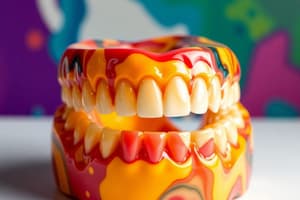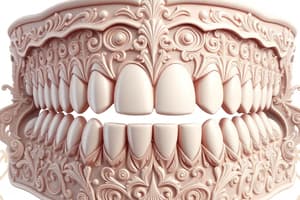Podcast
Questions and Answers
What is the purpose of packing acrylic resin into the mold?
What is the purpose of packing acrylic resin into the mold?
- To increase the vertical dimension of occlusion
- To accelerate the curing process
- To reduce the pressure applied on the acrylic
- To prevent shrinkage and porosity after polymerization (correct)
Why should pressure be applied gradually during the packing of a denture?
Why should pressure be applied gradually during the packing of a denture?
- To speed up the curing process
- To decrease the accuracy of detail in the final prosthesis
- To increase the risk of porosity in the final prosthesis
- To allow the resin to flow within the mold (correct)
What are the consequences of adding acrylic resin too early into the mold?
What are the consequences of adding acrylic resin too early into the mold?
- Prevents shrinkage and porosity in the final prosthesis
- Leads to an increase in vertical dimension of occlusion
- Results in a dense and well-packed prosthesis
- Causes porosity in the final prosthesis (correct)
When is it considered too late to pack acrylic resin into the mold?
When is it considered too late to pack acrylic resin into the mold?
What method is used to press the flask when packing a denture?
What method is used to press the flask when packing a denture?
Why should acrylic flash be trimmed away during the packing process?
Why should acrylic flash be trimmed away during the packing process?
What should be done to the teeth in the mold when applying cold mold seal?
What should be done to the teeth in the mold when applying cold mold seal?
Which component is used to characterize denture bases and create a lifelike appearance?
Which component is used to characterize denture bases and create a lifelike appearance?
In what ratio are the powder and liquid mixed for an average-sized denture when using acrylic resin?
In what ratio are the powder and liquid mixed for an average-sized denture when using acrylic resin?
During which stage of acrylic mixing does the mix become tacky, sticky, and adhere to the sides of the jar?
During which stage of acrylic mixing does the mix become tacky, sticky, and adhere to the sides of the jar?
Why is it important for the cold mold seal to be thin and even on all parts of the mold?
Why is it important for the cold mold seal to be thin and even on all parts of the mold?
Which component acts as a cross-linking agent in acrylic resin?
Which component acts as a cross-linking agent in acrylic resin?
What is the primary cause of inadequate softening of the powder by the monomer in denture processing?
What is the primary cause of inadequate softening of the powder by the monomer in denture processing?
What is the main consequence of too much monomer in denture processing?
What is the main consequence of too much monomer in denture processing?
What is the primary reason for contraction porosity in dentures?
What is the primary reason for contraction porosity in dentures?
Which factor is crucial in minimizing contraction porosity during denture processing?
Which factor is crucial in minimizing contraction porosity during denture processing?
What is the main reason for the linear contraction observed during denture processing?
What is the main reason for the linear contraction observed during denture processing?
How does excessive monomer affect the potential outcomes in denture processing?
How does excessive monomer affect the potential outcomes in denture processing?
What is the purpose of slowly cooling the flask on the bench?
What is the purpose of slowly cooling the flask on the bench?
Which step is NOT part of the de-flasking procedure?
Which step is NOT part of the de-flasking procedure?
What is the potential issue with heating the flask in an ordinary water bath as described?
What is the potential issue with heating the flask in an ordinary water bath as described?
Why should temperature and time be controlled during the curing of acrylic?
Why should temperature and time be controlled during the curing of acrylic?
In which heating technique does the temperature rise to boiling after reaching 72°C?
In which heating technique does the temperature rise to boiling after reaching 72°C?
What should be done to prevent breakage of the denture during de-flasking?
What should be done to prevent breakage of the denture during de-flasking?
What is the term used to describe the volatilization of the monomer due to temperature rises above the boiling point?
What is the term used to describe the volatilization of the monomer due to temperature rises above the boiling point?
How can the potential problem of gaseous porosity be eliminated during denture processing?
How can the potential problem of gaseous porosity be eliminated during denture processing?
What is the consequence of restricting dimensional change during cooling in denture processing?
What is the consequence of restricting dimensional change during cooling in denture processing?
Why is it important to cool the flask slowly during denture processing?
Why is it important to cool the flask slowly during denture processing?
What can cause gaseous porosity in denture material?
What can cause gaseous porosity in denture material?
How do modern heat-cured acrylics behave if the correct powder/liquid ratio is achieved in denture processing?
How do modern heat-cured acrylics behave if the correct powder/liquid ratio is achieved in denture processing?
Flashcards are hidden until you start studying
Study Notes
Curing of Acrylic
- The packed mold is heated (cured) in an oven or in water bath to control temperature and time.
- Two water bath heating techniques can be used: heating the flask in a special bath of water or in an ordinary water bath.
- The first technique takes 16 hours, while the second technique takes 2 hours to reach 72°C, then 1 hour at boiling temperature.
- The second technique has a shorter time but may cause distortion during deflasking and increase the amount of free monomer.
Cooling of the Flask
- After curing, the flask is cooled slowly on the bench in its water bath to relieve internal stresses.
- Slow cooling prevents the breakage of the denture caused by the difference in contraction between the acrylic and the mold material.
De-flasking Procedure
- The flask is removed from the clamp, and the upper and lower lids are removed.
- The two parts of the flask are separated using a plaster knife, and the denture is liberated with its model.
- The model is removed carefully, and if there is an undercut, it is split into two or three parts to remove them easily.
- The excess of acrylic is removed using an acrylic bur.
Processing Problems
- Powder/liquid ratio: too much polymer can result in a weak material, while too much monomer can result in excessive polymerization shrinkage, loss of fit, and gaseous porosity.
- Contraction porosity: occurs due to polymerization shrinkage, which can be minimized by using a powder/liquid system between 5 and 8%.
- Gaseous porosity: caused by the volatilization of the monomer, which can be eliminated by having a long curing period with a hold period at about 70°C.
- Processing strains: occur due to the dimensional change during cooling, which can be minimized by cooling the flask slowly.
Stages of Acrylic Resin
- Smooth dough-like stage: where the monomer diffuses into the polymer.
- Rubber-like stage: where the monomer penetrates further into the polymer, making it too stiff to be packed or molded.
- Stiff stage: where the acrylic resin becomes hard.
Packing of Acrylic
- It is the procedure of applying acrylic resin into the mold and pressing the flask to compensate for the contraction of the acrylic after polymerization.
- The acrylic resin should be placed in the mold and pressed in a clamp immediately.
- Too early or too late application of the acrylic resin can result in porosity, loss of detail, or movement of teeth.
Mixing Acrylic Resin
- Acrylic resin is a resinous plastic material of various esters of acrylic acid used as a denture base material.
- It is formed of a powder and liquid, with a ratio of 3 to 1 by volume for an average-sized denture.
- Stages of acrylic mixing: sandy stage, stringy or fibrous stage, and a smooth, stiff stage.
Studying That Suits You
Use AI to generate personalized quizzes and flashcards to suit your learning preferences.




